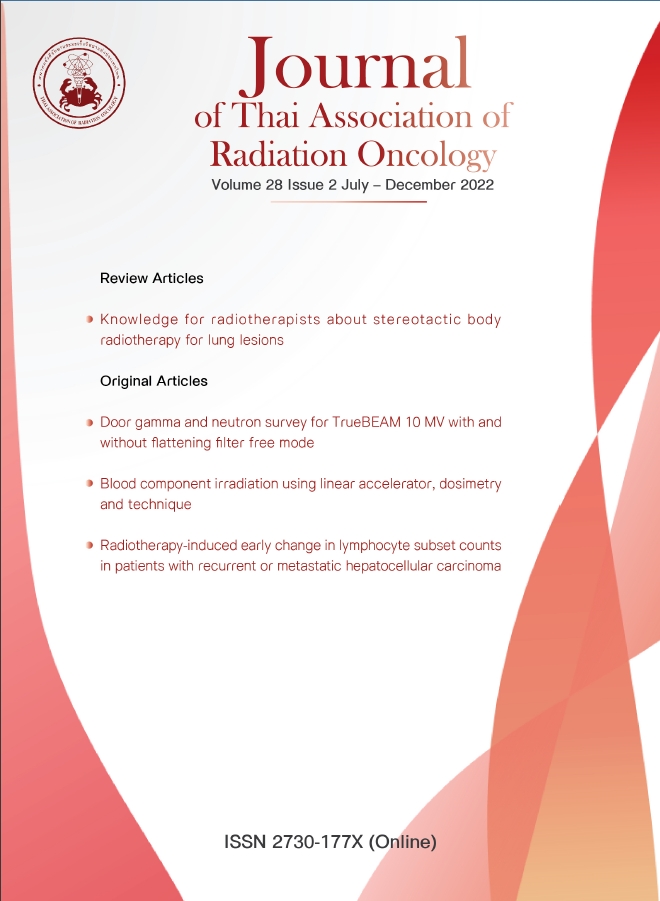Knowledge for radiotherapists about stereotactic body radiotherapy for lung lesions
Keywords:
Lung cancer, stereotactic body radiation therapy (SBRT), image-guided radiotherapy (IGRT), positioningAbstract
Stereotactic body radiation therapy (SBRT) is a technique that utilizes precisely targeted radiation to a tumor while minimizing radiation to adjacent normal tissue for lung cancer and lung metastasis. SBRT has been evolved as option for medically inoperable patients. Factors that are considered in selecting patients lung SBRT are performance status, option of treatments, disease-free interval, number of lesions, size of the tumor, histopathology of primary tumor. The overall goal of SBRT technique is to target tumor accurately, which depends on the positioning and selection of the immobilization device. Moreover, respiratory motion management should be carried out for moving target as recommended by the AAPM task group 76. To minimize the error of treatment, checking the position before irradiation is necessary. Image-guided radiotherapy (IGRT) is essential for SBRT.
References
Pastorino U, Buyse M, Friedel G, Ginsberg RJ, Girard P, Goldstraw P, et al. Long-term results of lung metastasectomy: prognostic analyses based on 5206 cases. J Thorac Cardiovasc Surg 1997;113: 37-49.
กานต์นฤนิมิต ด. การฉายรังสีร่วมพิกัดในผู้ผู้ป่วยมะเร็งระยะแพร่กระจายไป J Thai Assn of Radiat Oncol. 2018; 24: 27-50.
Okunieff P, Petersen AL, Philip A, Milano MT, Katz AW, Boros L, et al. Stereotactic Body Radiation Therapy (SBRT) for lung metastases. Acta oncologica. 2006;45:808-17.
Milano MT, Katz AW, Zhang H, Okunieff P. Oligometastases treated with stereotactic body radiotherapy: long-term follow-up of prospective study. Int J Radiat Oncol Biol Phys. 2012;83:878-86.
Norihisa Y, Nagata Y, Takayama K, Matsuo Y, Sakamoto T, Sakamoto M, et al. Stereotactic body radiotherapy for oligometastatic lung tumors. Int J Radiat Oncol Biol Phys 2008;72:398-403.
De Ruysscher D, Wanders R, van Baardwijk A, Dingemans AM, Reymen B, Houben R, et al. Radical treatment of non-small-cell lung cancer patients with synchronous oligometastases: long-term results of a prospective phase II trial (Nct01282450). J Thorac Oncol 2012; 7:1547-55.
De Rose F, Cozzi L, Navarria P, Ascolese AM, Clerici E, Infante M, et al. Clinical Outcome of Stereotactic Ablative Body Radiotherapy for Lung Metastatic Lesions in Non-small Cell Lung Cancer Oligometastatic Patients. Clin Oncol (R Coll Radiol) 2016; 28:13-20.
Maemondo M, Inoue A, Kobayashi K, Sugawara S, Oizumi S, Isobe H, et al. Gefitinib or chemotherapy for non-small-cell lung cancer with mutated EGFR. N Engl J Med 2010; 362:2380-8.
Shaw AT, Kim DW, Nakagawa K, Seto T, Crino L, Ahn MJ, et al. Crizotinib versus chemotherapy in advanced ALK-positive lung cancer. N Engl J Med 2013; 368:2385-94.
เงินเถื่อน ว. การเปรียบเทียบความคลาดเคลื่อนจากการจัดท่าผู้ป่วยฉายรังสีผู้ป่วยมะเร็งปอดโดยใช้อุปกรณ์ยึดตรึงสองชนิด. J Thai Assoc Radiat Oncol. 2018;24:29–37.
ทวีบุญ น, ตินทุกานนท์ ค, เดชะวงศ์สุวรรณ ส. การศึกษาเปรียบเทียบความคลาดเคลื่อนของตำแหน่ง isocenter ระหว่างแนวเหนือและใต้ต่อ nipple สำหรับการฉายรังสีมะเร็งบริเวณทรวงอกและช่องท้องโดยการใช้ภาพ KV Orthogonal หรือ Cone-beam computed tomography (CBCT) ของโรงพยาบาลศิริราช. J Thai Assoc Radiat Oncol. 2018;24:25–34.
Erhunmwunsee L, Tong BC. Preoperative evaluation and indications for pulmonary metastasectomy. Thorac Surg Clin. 2016;26:7.
Benedict SH, Yenice KM, Followill D, Galvin JM, Hinson W, Kavanagh B, et al. Stereotactic body radiation therapy: The report of AAPM Task Group 101. Med Phys. 37. 2010.
Wu AJ, Williams E, Modh A, Foster A, Yorke E, Rimner A, et al. Dosimetric predictors of esophageal toxicity after stereotactic body radiotherapy for central lung tumors. Radiother Oncol. 2014;112:267–71.
Harder EM, Chen ZJ, Park HS, Mancini BR, Decker RH. Dose-volume predictors of esophagitis after thoracic stereotactic body radiation therapy. Am J Clin Oncol. 2017;40(5):477–82.
Timmerman R, Paulus R, Galvin J, Michalski J, Straube W, Bradley J, et al. Stereotactic body radiation therapy for inoperable early stage lung cancer. JAMA. 2010;303:1070–6.
Stephans KL, Djemil T, Tendulkar RD, Robinson CG, Reddy CA, Videtic GMM. Prediction of chest wall toxicity from lung stereotactic body radiotherapy (SBRT). Int J Radiat Oncol Biol Phys. 2012;82:974–80.
Bongers EM, Haasbeek CJA, Lagerwaard FJ, Slotman BJ, Senan S. Incidence and risk factors for chest wall toxicity after risk-adapted stereotactic radiotherapy for early-stage lung cancer. J Thorac Oncol. 2011;6:2052–7.
Nagata Y, Takayama K, Matsuo Y, Norihisa Y, Mizowaki T, Sakamoto T, et al. Clinical outcomes of a phase I/II study of 48 Gy of stereotactic body radiotherapy in 4 fractions for primary lung cancer using a stereotactic body frame. Int J Radiat Oncol Biol Phys. 2005;63:1427–31.
Downloads
Published
How to Cite
Issue
Section
License
Copyright (c) 2022 Thai Association of Radiation Oncology

This work is licensed under a Creative Commons Attribution-NonCommercial-NoDerivatives 4.0 International License.
บทความที่ได้รับการตีพิมพ์เป็นลิขสิทธิ์ของวารสารมะเร็งวิวัฒน์ ข้อความที่ปรากฏในบทความแต่ละเรื่องในวารสารวิชาการเล่มนี้เป็นความคิดเห็นส่วนตัวของผู้เขียนแต่ละท่านไม่เกี่ยวข้องกับ และบุคคลากรท่านอื่น ๆ ใน สมาคมฯ แต่อย่างใด ความรับผิดชอบองค์ประกอบทั้งหมดของบทความแต่ละเรื่องเป็นของผู้เขียนแต่ละท่าน หากมีความผิดพลาดใดๆ ผู้เขียนแต่ละท่านจะรับผิดชอบบทความของตนเองแต่ผู้เดียว




